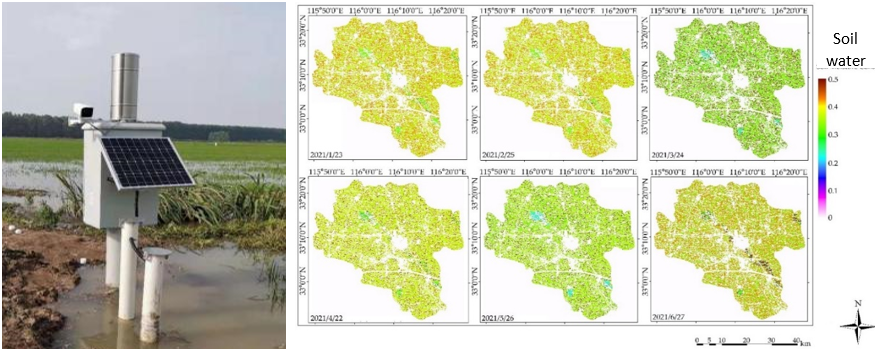Wang Shaoli, Jiao Pingjin
I. Research Background
China is one of the countries that are most vulnerable to waterlogging in the world. With the intensification of global climate change and human disturbance, the mechanism of waterlogging has also undergone profound changes. The rapid development of modern agriculture and the shift of the crop planting structure towards a high value-added one have posed new requirements and challenges to farmland waterlogging prevention and mitigation. In this context, China Institute of Water Resources and Hydropower Research (IWHR) took the lead in undertaking the “Research on Technologies for Farmland Waterlogging Monitoring, Forecasting and Mitigation”, a key project funded by the National Key R&D Program “Major Natural Disaster Monitoring, Warning and Prevention”. The project passed the comprehensive performance evaluation in July 2022.
II. Research Results
1. Technology and device for remote sensing monitoring of farmland waterlogging
The project developed a dedicated device to monitor waterlogging on farmland and supporting monitoring software. The current situation that waterlogging monitoring is mainly manual and monitoring parameters are few has been changed. The project developed a remote sensing-based flooding area extraction algorithm and proposed a soil moisture extraction method based on multiband synthetic aperture radar (SAR) data. It enables the assimilation of time series remote sensing data with predicted values from dynamic hydrological models and improves the accuracy of spatial and temporal distribution of soil moisture extraction; it put forward a data-driven intelligent field water table forecasting method based on air-ground coordination and a big data platform for integrated monitoring of farmland waterlogging and open space has been established to realize the efficient management and application of waterlogging data.

Figure 1 Waterlogging monitoring device and the inversion results of soil water content distribution in Lixin County based on remote sensing data assimilation
2. Technology for forecasting, early warning and optimized scheduling of waterlogging
The project built a simulation model of farmland waterlogging process considering the runoff of different underlying surface and the jacking discharge of plain river network. With a simulation error of less than 7%; it developed a technology for joint forecasting and early warning of multiple variables including farmland waterlogging and node water levels of a backbone project, by introducing intelligent algorithms, with an error of less than 10% in the five-day forecast of water levels at key nodes; it developed a system that integrates early warning of farmland waterlogging, optimized project scheduling and emergency response analysis, which solved the problem of poor performance of farmland waterlogging drainage projects in terms of optimized scheduling and emergency response timeliness.
Figure 2 Architecture of the disaster warning-optimized project scheduling-emergency response analysis system
3. Farmland waterlogging drainage project technologies
The project created a field drainage efficiency improvement technology based on inverted filters and increased flow outlet siphoning to raise the drainage discharge significantly; The project developed a ditch-channel coordinated regulation technology and a combined ditch-pond diversion device for waterlogging drainage projects and its operating parameters; it developed an integrated sluice gate station monitoring device and a scheduling system by integrating hydrological information sensing, operation monitoring and automatic control. The research found that optimal time allocation regulation can reduce the peak flow of the ditch by 10%. Changing the depth and width of the diversion weir can result in peak reduction and detention rates of more than 85%.

Figure 3 Combined ditch-pond diversion device and its peak reduction effect
4. Comprehensive technology integration model for waterlogging mitigation
The project innovatively proposed a controlled drainage technology through the main drainage ditch and its operating parameters. It combines the technology with field drainage engineering measures combining light and dark drainage and waterlogging monitoring, forecasting and early warning measures. The project created a new comprehensive technology integration model of “drainage-storage-control” for waterlogging mitigation, which is suitable for coordinated regulation of surface water and groundwater in areas prone to waterlogging and droughts. This applies to the coordinated regulation of surface water and groundwater in areas prone to waterlogging and drought. The project creatively put forward the rice - crayfish mixed farmland water resources management model. The rice - crayfish mixed cropping measures, the combination of ditch - pond technology and waterlogging monitoring, forecasting and early warning technology were combined. A new integrated technology model of "farmland retention - pool storage - ditch regulation - sluice (station) control" has been created for waterlogging prone areas.

(a)
Areas prone to waterlogging and droughts
(b) Areas prone to waterlogging
III. Promotion and Application
Research results such as the technology and device for stereoscopic monitoring of waterlogging, the forecasting, early warning and emergency scheduling technology and the disaster mitigation project technology have been put into pilot application on 139,200 mu of farmland in provinces of Hubei, Anhui and Jiangxi; and relevant results have also been applied in the modernization of irrigation areas, water network planning, planning, design, construction and management of farmland water conservancy projects, providing important technological support for the practice of farmland waterlogging prevention and drainage projects.